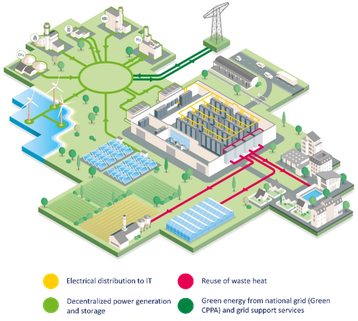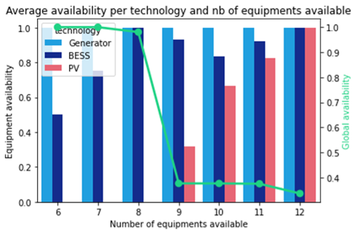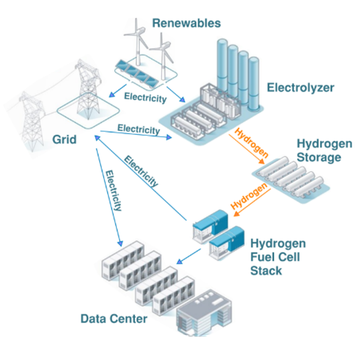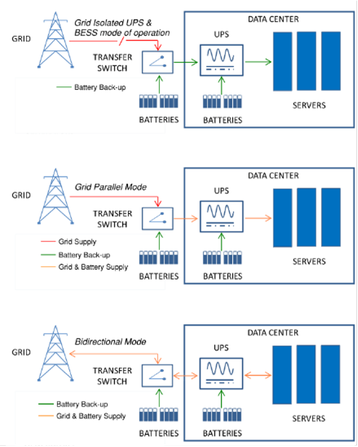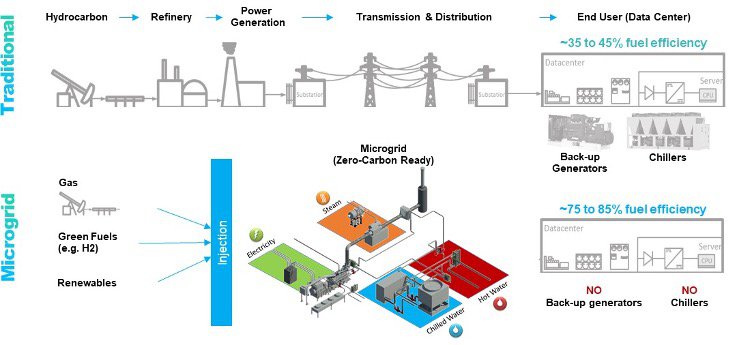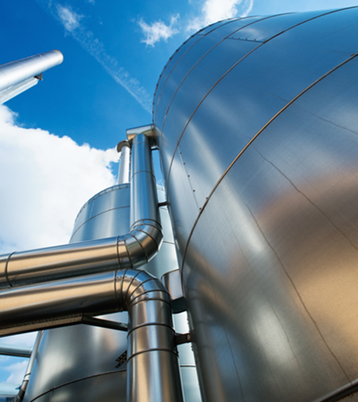As the climate crisis rages on, there is an urgent need to decarbonize our data centers, whilst at the same time accommodating the huge projected increase in data transmission, processing and storage needed to feed the requirements of the modern world.
The classic scenario of connecting data centers to national electricity and water networks is becoming increasingly unsustainable. As a result, we now need to be looking towards microgrids or campus scale utilities networks using decentralized and decarbonated generation. Firstly, to guarantee the resilience of utilities serving the data center and secondly, future-proof the schemes that allow for the incorporation of zero carbon generation, as new technologies and fuels come to market.
Not only will these new networks provide resilient and green services to the data center, but will also be able to provide support to local networks and communities by providing waste heat, zero carbon cooling and electricity to nearby consumers, as well as grid support services in the form of demand side reduction and firm frequency response.
Microgrids are integrated utilities services networks, incorporating thermal and electrical distribution, cabling, control & monitoring and water services, as well as lighting and urban support systems including lighting, security, and electric vehicle (EV) charging.
The scale of these networks can range from a single large data center to a number of buildings on a single site, to a district scale set up where several different sites and buildings are connected.
The decentralized generation plant serving the network will be designed to be N+2, or whatever is stipulated by the Uptime Institute to achieve the necessary Tier rating. An energy center located either on or adjacent to the site will usually contain all items of power, heat, and cooling generation to allow for ease of maintenance and operational control. The energy center will also contain ancillary equipment such as circulation pumps and water treatment plant.
One of the advantages of an integrated utilities microgrid is that it can be monitored, controlled, and coordinated using one centralized control system. This system will also provide details of overall system efficiency logged to date under different conditions and, with the implementation of AI and machine learning, will continuously work to improve efficiency.
Elements of a microgrid
The electrical distribution system will need to be sized to allow for the total eventual load of the data center, plus any potential power export connections planned in the future. Unless running in island mode, there will be a connection to the local electrical supply network as well as to the on-site generation plant.
The design of the electrical microgrid needs to be undertaken so that there are no single points of failure and so that the power supply can be maintained, even when there is a failure in one part of the system, or should the system need to be isolated for repair or maintenance.
The decentralized power generation plant should be designed for at least N+2 resilience so that even with one generator being out of service for maintenance, the failure of another will not affect the capacity of the generators to provide power under full load.
The energy center will also contain other power supply sources, including batteries and possibly fuel cells for the conversion of hydrogen or other gas to electricity as a means of importing renewable energy into the system.
This brings into focus the new concept of N+k where multiple renewable energy sources can be used together with electrical storage as the resilient back-up for part of the data center’s power generation. These generation assets could be PV solar panels, wind turbines or other generators using biogas, biomass, energy from waste or other biofuels.
Engie has carried out studies on the effectiveness of the N+k concept. The bar chart below shows the predicted results for a specific use case. The concept will be developed further in a next editorial article.
Renewable energy sources such as solar farms or wind turbines can be used directly as a primary power source for data centers. This is in addition to potentially providing secondary power, by charging batteries or, via electrolysis, producing green hydrogen which can be stored and then converted back to electrical power in fuel cells.
An important part of the design process will be to provide the optimum mix between batteries and hydrogen storage/fuel cells. Based on the space available on site, operators must figure out the power and back-up period required to bring any stand-by generators on-line from a cold start.
The connection between the microgrid power distribution system and the main power grid will, in certain countries, enable us to provide grid flexibility services such as demand side reduction and firm frequency response, which, apart from providing a useful service to the main grid, can often be monetized to provide a useful source of additional income to the data center.
The use of cogeneration for the primary power supply to the data center means the microgrid can operate at a much higher efficiency by using the heat off-take to supply absorption chillers, which in turn will provide cooling for the data center.
Taking gas engines as an example, a 2 MWe generator would provide 2.2 MWth of heat from the cooling jacket and the exhaust stream. The temperature of the water from the jacket is around 80°C and from the exhaust stream up to 400°C.
For gas turbines, the exhaust temperature is likely to be much higher (around 600°C). In both cases, steam can be supplied from the cogeneration (or CHP – combined heat and power) sets via waste heat boilers to two-stage absorption chillers, which provide a high resilience source of chilled water for data center cooling.
In general, with CHPs of the size we require, there will be an excess of heat generated as steam and therefore it is often beneficial to add a steam turbine to improve overall system efficiency. The absorption chillers operating at these higher steam temperatures would usually result in coefficients of performance (COPs) of at least 1.4
In the future, both gas engine as well as gas turbine generators will be able to accept an increasing blend of green fuels such as hydrogen, ammonia, biogas, and methanol with the ultimate aim of running on 100 percent green fuels as supply chains develop. Gas turbines, in this respect, are far more flexible in accepting different fuels and we believe that these will become the preferred choice for zero carbon decentralized generation moving forward.
The generation of chilled water in the energy center as described above will connect to the data center using a high resilience flow and return distribution system, where there are no single points of failure and the chilled water supply can be maintained – even when there is a failure in one part of the system or if it has to be isolated for repair or maintenance – this includes dual chilled water flow and return connections into each building.
Such a new energy concept has turned out to be far more energy efficient than the current (whereby a data center is only connected to the utility grid) drastically reducing the amount of net energy losses.
Another facet of the microgrid is its ability to export waste heat from the data center site, which can then be used by industrial processes as well as commercial or residential buildings located nearby. This heat takes the form of excess energy from the power generation process as well as low grade heat from data center cooling systems.
For both heating and cooling, the inclusion of thermal storage in the design is key in order to reduce the peaks and troughs in demand, as well as being able to reduce the size of the cooling plant. Extensive modelling is required at design stage in order to determine the optimum volume of storage required based on the demand variations across a 24-hour period.
For these cases, it is important that financial viability is tested by comparing the profiles of heat availability from the site and the heat demand profiles from the various consumers on the network.
For the data center heat generation profile, the ideal customers would be industrial users of heat who will often have a steady, year-round high demand as part of their production processes.
Depending on the main source of waste heat, if the waste heat network is low grade (generally around 30°C, and up to 60°C with the advancement of liquid cooling) then heat pumps will usually be required at the point where the waste heat network enters each building in order to raise the temperature to around 65°C, the usual level required in most buildings for domestic hot water and heating.
Next steps
The concept of an integrated utilities microgrid, where high-resilience heating, cooling and power is provided by an external services provider (and outsourced from the data center itself) will be the most practical way of data center operators and developers to:
- Reduce their reliance on national power grids to provide redundant power supplies
- Provide a structure to achieve their roadmap to carbon neutrality by progressively connecting new technologies and fuels as they come to market
- Allow external services companies to design, build, operate and fund the microgrid utilities distribution and generation
- Reduce the footprint of the data center site
- Reduce Capex and Opex across the life of the installation.
To achieve optimum design in terms of renewable energy storage, distribution and life cycle analysis of the energy center, financial modelling of this new concept is taking place using different design scenarios. This will bring to light any required investment during operational life, ensuring competitively low energy costs for data center operators, as well as a steadily increasing trend to that all-important zero carbon goal.
Want to find out more? For a deeper dive, stay tuned for our next editorial. In the meantime, you can visit www.engie.com for more information
More from Engie
-
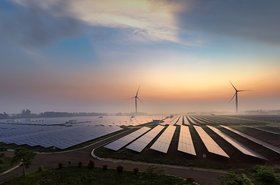
Sponsored Actions over (buzz)words
What does it actually mean to be green?
-
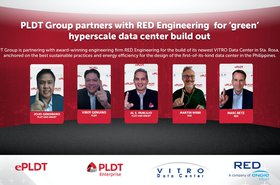
Sponsored PLDT Group partners with RED Engineering for green hyperscale data center build out
The PLDT Group has partnered with award-winning engineering firm RED Engineering for the build of its newest VITRO data center in Sta. Rosa, Laguna
-
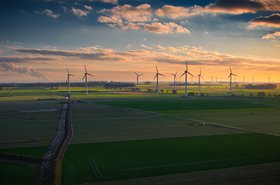
Sponsored Will decarbonization impact future data center design?
A closer look at the prosumer approach, with Eric Lamendour of Engie

